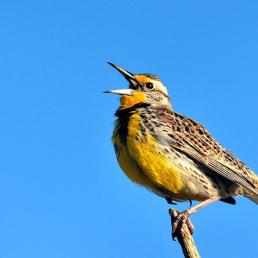

Join BirdNote tomorrow, November 30th!
Illustrator David Sibley and actor H. Jon Benjamin will face off in the bird illustration battle of the century during BirdNote's Year-end Celebration and Auction!
As darkness grows, bats, like this western long-eared bat, replace swallows in the business of catching flying insects. The night shift has come on duty. Both swallows and bats consume vast quantities of insects. Both are critical components of healthy environments. But the way they fly is strikingly different. Learn about plants that attract bats. See photos of bats at AnimalDiversityWeb. Thanks to Michael Durham, OregonWild, for this composite photo.
BirdNote®
Shift Change - Swallows to Bats
Written by Bob Sundstrom
This is BirdNote!
[Crickets]
At dusk, the last swallows of the day glide over a field in search of insects. Already they have been joined by a few bats, whose sudden aerial twists and turns show that they, too, are tracking insects. [Crickets; Barn Swallows in flight] We are watching a shift change. As darkness grows, bats replace swallows in the business of hawking—or diving for and catching flying insects. The night shift has come on duty.
[Squeaks of Myotis, little brown bats]
Both swallows and bats consume vast quantities of insects; both are critical components of healthy environments. But the way they fly is strikingly different.
While birds have relatively rigid wings, the wings of bats are highly flexible and more curved. Bats’ wings have more than two dozen independent joints, rather like a human hand, all covered in a fine membrane.
This unique wing structure gives flying bats exquisite control over the shape of their wings and enables remarkable aerial feats. A bat can make a 180-degree turn in less than half its wingspan, a shift beyond the means of any bird. And bats can fly with badly damaged wings or carry objects up to half their own weight, with little loss of flight control.
You can help the night shift by planting certain native plants and by learning more about bats. For links to this information, come to BirdNote.org. I’m Frank Corrado.
###
Sound of the cricket and squeaks of bats provided by The Macaulay Library at the Cornell Lab of Ornithology, Ithaca, New York.
Myotis little brown bats recorded by S.R. Pantle. Single cricket recorded by T.J. Walker
Producer: John Kessler
Executive Producer: Chris Peterson
© 2010 Tune In to Nature.org October 2010
ID#103007batsKPLU bats-01









